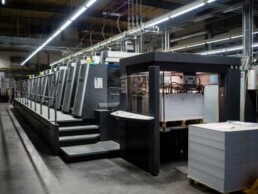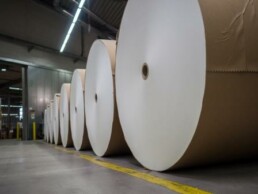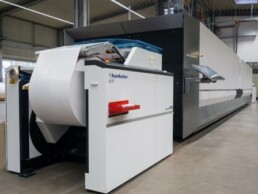What Exactly Is the Difference Between Offset Printing and Digital Printing?
At Eversfrank Group, we offer printed products that can be produced using two different printing processes: Offset printing and digital printing. But what are the differences between the printing processes? And which is the right one for your product?
Offset printing is particularly suitable for large print volumes such as catalogues, magazines or advertising brochures. We usually handle print jobs with a print quantity of 20,000 copies or more. Offset printing is an indirect printing process in which the printed image is first transferred to a printing plate and then to a rubber blanket, which then applies the ink to the paper. A printing plate is created for each of the four primary colours (CMYK = Cyan, Magenta, Yellow, Black). The printed image on the paper is therefore created by an optical mixture of the four primary colours.
In offset printing, a distinction is also made between sheetfed offset and web offset. In sheetfed offset, the paper is printed on sheets, whereas in web offset the paper comes from a large paper roll. In sheetfed offset, paper with a higher grammage is printed – for example the high-quality covers of catalogues or magazines. But content can also be produced in sheetfed offset. In sheetfed offset it is also possible to apply various special colours and coatings to the printed product and to perforate or punch it.
In web offset, on the other hand, the papers from the roll are usually of a lower grammage and are intended for very large print runs – for example, for advertising brochures that are printed as a scatter product in runs of millions. Costs also play a role, of course: papers with a lower grammage are cheaper.
In digital printing we use inkjet printing machines. Here, tiny droplets of liquid ink are applied directly to the paper by means of air pressure. This means that no printing plates have to be exposed beforehand, which makes digital printing much more flexible. For this reason, digital printing is ideal for producing individualised print products whose contents are tailored exactly to one person. This is also called one-to-one marketing.
Based on digital data, such as an order history from an online shop, print mailings, for example, are printed with exactly those products that might be of interest to the respective customer. And this for each individual customer. Because everyone has different tastes, a different size or a different budget. Such individualisation is not only possible with postcards, but also with catalogues or magazines. More info on this can be found in our blog post “What is variable data printing?“.
Feel free to contact us for more information around our offset and digital printing options.
In a nutshell:
Offset printing
- Ink is applied to the paper indirectly via printing plates and blankets
- Printing is done on sheets of paper (sheet-fed offset) or on a huge paper roll (web offset)
- Production of long, static runs
- Economical production of long runs
Digital printing
- Ink is applied directly to the paper by air pressure
- Production of short and long runs
- One-to-one marketing
- Print products precisely tailored to recipients on the basis of digital data
- Individualised print mailings
Marie Hennschen




